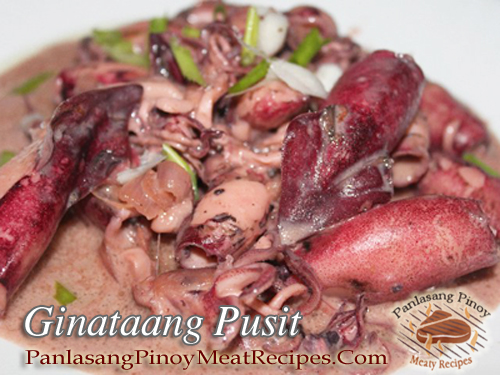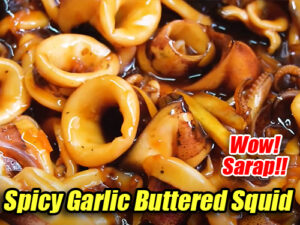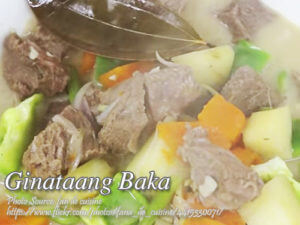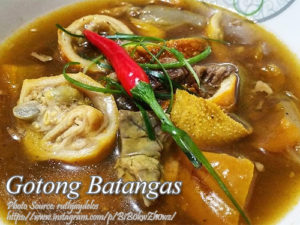“Ginataan” or coconut milk based dishes are varied in Filipino cooking. There are lots of Filipino recipes that includes coconut milk from viands to desserts, pork, chicken, beef, fish or shellfish. This simple recipe of ginataang pusit only requires few ingredients and will take just a few minutes to cook. Cleaning the squid takes a bit of work because you have to remove the ink sac, innards, beak and the transparent back bone. Usually squid have a transparent film like backbone unlike cuttlefish that have a bony boat shaped, white color, chalky and brittle backbone called cuttlebone.
The Versatility of Coconut Milk in Filipino Dishes
For me, coconut-based foods remind me of the several times my family dined together as a family and hastened to the table with wide eyes to dig into that comforting ginataan whatever it was. Whether it was a rich meaty preparation or a light seafood concoction, coconut milk sure gave it that richness and lusciousness. One of my favorite dishes is something my Tita Elsa would make during gatherings-the rather simple but yummy dish of squid cooked in coconut milk. That always reminds me of those cozy evenings in her kitchen, the smell of sautéing garlic and ginger filling the air.
The Charm of Coconut Milk in Filipino Cuisine
Coconut milk, or gata, is a staple in Filipino cooking. Whether it’s in the savory forms of ginataang manok or even in desserts like ginataang bilo-bilo, this ingredient has been deep-rooted in our culinary tradition. I remember my uncle, Tito Nestor, a Bicolano who always said that coconut was an indispensable part of his daily meals. Well, for them, no meal is complete unless something is cooked in coconut milk. Their squid in gata is a bit more spicy, as they are fond of siling labuyo.
This simple dish is beautiful. Unlike the other complicated recipes that require an hour or more for marination or preparation, this comes together in less than half an hour. It’s perfect for those nights when you want to serve something that feels special but don’t have hours to spend in the kitchen. The most time-consuming part of the process is cleaning the squid, which, although a bit tedious, is absolutely necessary for a perfectly done dish.
The Delicate Art of Cleaning Squid
Cleaning squid is one of those tasks I never really learned until I was in my twenties. When I was a kid, my Nanay or Lola did all the prep work while I just sat and watched from afar, too squeamish to join in. Not until my sister, Ate Lani, came home from a trip to Iloilo where she learned how to make squid in coconut milk was I more than happy to learn, by contribution. She even showed me how to take out the ink sac, the beak, and the transparent backbone – something that looked so easy when she did it but took me a few tries to perfect.
The secret, she said, was patience. Squid is so fragile, and you do not want to tear the flesh as you clean it. Still, the hard work always pays off. Once you have your squid cleaned and prepared, everything else falls into place.
Putting Everything Together in the Pan
Whenever I cook, I always start by sautéing garlic, onion, and ginger. This becomes the base of most Filipino dishes. As soon as you sauté them and the aroma spreads to the entire kitchen, you know it’ll remind you instantly of Lola’s house because these always are considered indicators that something good is coming.
When the squid hits the pan, stir for a few minutes. Now don’t overcook it because that’s about when it will start to cook since the coconut milk is simmering. Squid is notorious; too long on the heat and it turns rubbery. My Tita Elsa always warned me against wandering away from the stove when cooking squid, and I took that for good advice.
Once the squid is nicely browned, it is time to introduce the star of the dish: coconut milk. There is something almost therapeutic about how this creaminess just covers the squid, making the dish almost comforting. Of course, I do add salt and pepper and adjust to taste. In my home, we add in a few green chili peppers to give it that extra kick. My Kuya Ben would say that the dish would not be complete without at least one chili per serving, though I somehow find it better with a milder spice.
The Role of Squid in Philippine Kitchen
Squid had long been one of the Filipino favourite delicacies. The dish is inexpensive, adaptable, and ready in just a few minutes of cooking, which makes it a go-to option for busy households. Whether grilled, fried, or stewed in coconut milk, it is always welcome on the dining table. Others say that the popularity of squid dishes in the country comes from the fact that the Philippines is a natural archipelago where ample seafood is easily accessible. That might be true, but I think it is more than that. Cooking squid, especially in coconut milk, brings a feel of nostalgia. It reminds me of simple times. It reminds me of how the whole family sat down at the dinner table, shared their stories, and laughed over food made at home.
The Final Dish: A Taste Home
With the coconut milk so well-blended, thickened to a perfect consistency and the dish done, it’s already good to be eaten. For my taste, it goes really well when steamed rice is served with it. Sometimes, if available, a side of pinakbet or laing comes along. Every biting is filled with tender squid and rich coconut sauce, to say nothing of the heaviness from the pungency of green chilies.
Every time I cook this, it feels like one of the numerous times my family and I sat at that table passing plates and stories. There’s just something heartwarming about a dish which not only fills your belly but also feeds the soul. So, for those trying this dish for the first time, I hope you find that same comfort and connectivity you find with mine.
How to Cook Ginataang Pusit (Squid in Coconut Milk)
Ingredients
- 1 kilo medium sized squid
- 1 cup coconut milk
- 2 pcs green chili peppers sliced (optional)
- 1 tsp. black pepper ground
- spring onions chopped
- 1 pc medium size onion chopped
- 3 cloves garlic minced
- 1 inch ginger slivered
- 2 tsp. patis or fish sauce
- 1 tsp. salt
Instructions
How to cook ginataang pusit:
- Clean the squid by removing the beak, ink sack and transparent back bone.
- Saute garlic, onion, and ginger for a few minutes then add the squid.
- Stir fry for a few minutes again until the squid are slightly cooked.
- Then pour the coconut milk and season with salt and pepper, adjust the amount if necessary.
- Simmer again for a few minutes until the sauce is thick then add the green chili peppers.
- Don't overcook so the squid won't get too tough.
- Remove from fire and serve hot.
Notes
Cooking Tips:
Thoroughly Clean the Squid
Clean the squid slowly for the best flavor and texture. Do not leave any part of the ink sac, beak, and transparent backbone uncarefully cleaned as the flesh might be torn apart. The better the squid is cleaned, the better it absorbs the coconut milk and seasoning to give the final dish a good taste.Avoid Overcooking Squid
Squid cooks rapidly and can become overly rubbery if it's left on the heat for too long. The moment it turns opaque and curls into a ball, it is normally cooked. And of course, you will be continuing cooking it in the coconut milk, so don't stir-fry too long.Adjust the Coconut Milk Consistency
For a creamier sauce, you may simmer the coconut milk slowly until it thickens without boiling too fast. You may also add a little bit of water if you like the sauce not to be very heavy or watch and adjust the time for simmering. That's the beauty of how adjusting the thickness helps in controlling the richness of the dish according to how you want it done.





